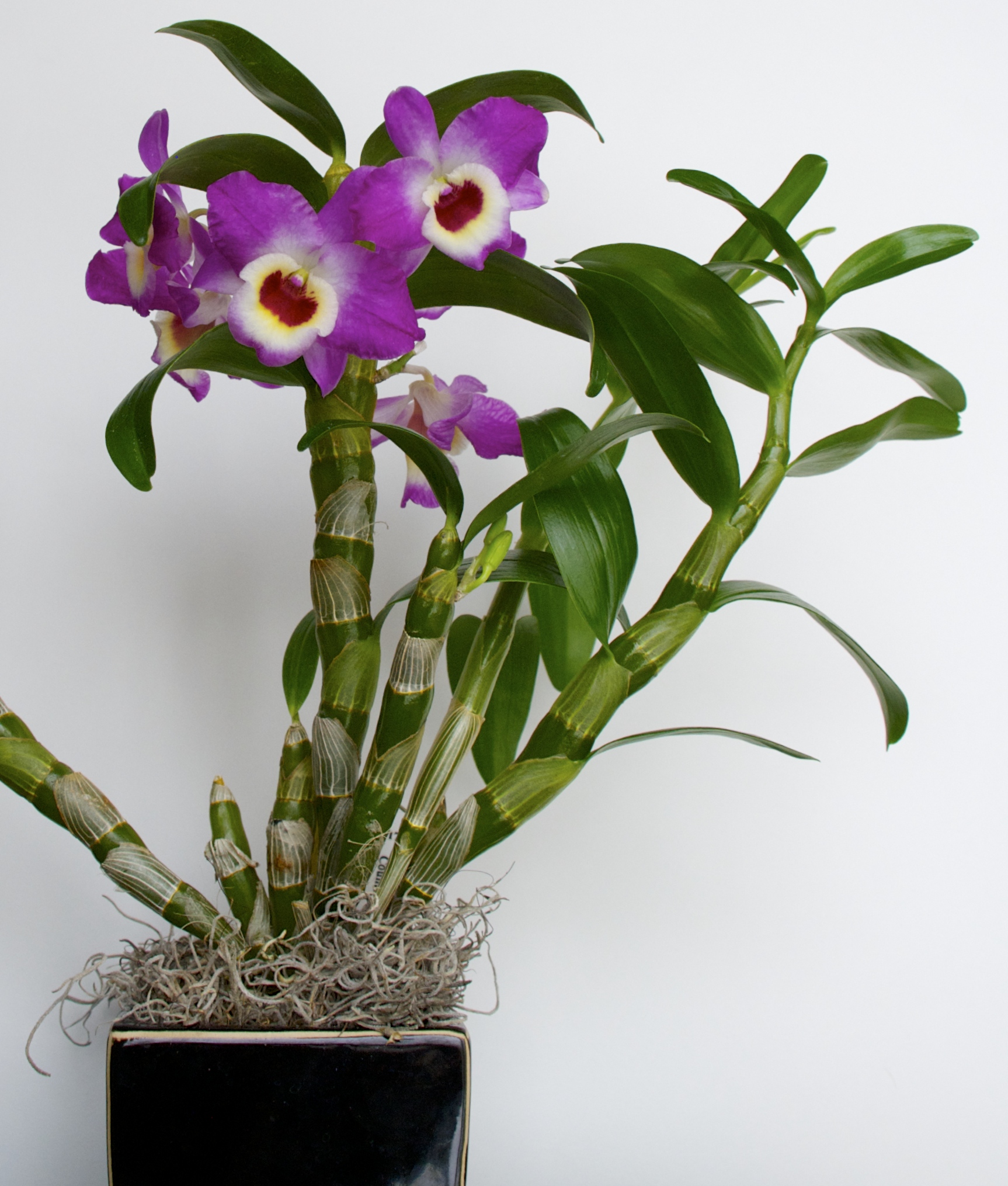Table Of Content

Most orchids suffer when grown indoors and will refuse to flower due to lack of light. Whereas the habitat of most orchids – like that of most common houseplants — is the tropical rainforest, there is a significant difference between the niches they inhabit. Common indoor plants live on the forest floor where light is limited while orchids are typically perched on branches high up in tree canopies where light is abundant. Also, keep in mind that the shadiest outdoor exposure is a lot sunnier than the brightest indoor exposure. The easy answer for when to water most orchids (including Phalaenopsis and Cattleya) is just before they go dry. It could be every few days or even every couple of weeks, depending on the orchid species and the environment in your home.

Test Garden Tip
Apply tepid water to your orchid until it runs through the pot and out of the drainage holes. You don’t want your orchid to sit in the water and stay wet for too long; this encourages root rot. Because of this it's a good to empty out the saucer your orchid sits in if it collects a lot of water. Shipments of plants to Florida, Hawaii, Puerto Rico, Louisiana and Mississippi require inspection by state agricultural department personnel which will add $40 to the cost of an order. Liven up your space with the most exclusive variety of orchids, plants, containers, and more. Mary Marlowe Leverette is one of the industry's most highly-regarded housekeeping and fabric care experts, sharing her knowledge on efficient housekeeping, laundry, and textile conservation.
Master Gardener: What’s happening to our naval orange tree?
Located at North Baldwin Avenue in the city of Arcadia, the seven-acre botanical garden has a Tropical Orchid Greenhouse inside, which is home to a remarkable collection of wild orchid plants in Los Angeles. Your potting material will eventually start to decompose, especially bark. You should repot your orchids in new bark every year or two because it won't drain as quickly as it decomposes.
Multicolor Orchid House Plant in 7-oz Planter
But by the time you journey south to Orange County, in any event, there are a large number of orchid species you can grow outdoors in containers, even if most will need shade cloth to protect them from the hot sun. To learn more about growing orchids outdoors in Southern California, visit fascinationoforchids.com. To find orchids for purchase, visit orchidwire.com where a list of orchid growers throughout California is provided. These plants would be mature and approaching specimen size in a 5- or 6-inch pot, and will grow easily and reliably, flowering at least once a year, with flowers lasting at least one month, if not more. Cynorkis Longwood Pink Gem is a hybrid between Cynorkis lowiana × Cynorkis fastigiata, and is remarkable for a number of reasons. The most amazing aspect of this hybrid is that it grew from seed to flowering in one year, two months, and six days!
Live Like 007 In This $100 Million Thai-Inspired Malibu Oasis - Forbes
Live Like 007 In This $100 Million Thai-Inspired Malibu Oasis.
Posted: Mon, 28 Sep 2020 07:00:00 GMT [source]
If you feel the top inch with your finger, it should feel bone dry. If your orchid is in a transparent plastic pot, as most are, you can also see if there’s obvious signs of moisture in there. The roots inside the pot can help guide you when water is needed; if they're bright green, they're still hydrated, but if there's a silvery tint to them, they need watering. Most orchids are native to tropical rainforests, so they’re designed to thrive a humid, hot climate with sudden rainfall.
Leaves Turning Yellow
Wait until you're sure your plant is done flowering before repotting your orchid. These orchids and other tropical plants are maintained in three off-view greenhouses and one public conservatory, totaling over 26,000 square feet of space. Controlled humidity that's 40% or higher is ideal for moth orchids, especially if the air around them continues to circulate.
❤ COLLECTION FOR MOM ❤
Tour through 13 model homes now on display at the World of Model Homes® in Kent. Don't just imagine luxury, experience first hand at one of our many model homes. In 1903 Royal Botanic Gardens, Kew in the UK registered the first two hybrids, and then 115 years passed before the next hybrid was registered.
Move-in Ready Homes
Moss is a good choice for these species because it supplies them with moisture for longer. You can also grow these water-loving orchids in fine-textured bark, but bark still won't hang on to moisture as long as moss, so you'll have to water them more frequently. Designed for display, the original Orchid House was constructed more than 100 years ago as one of two classically styled glasshouses that flank the Main Conservatory. The Orchid House’s bronze display case was added in 1929 and then restored in 1966.
If you place an orchid in the shower, you may consider leaving the fan or a dehumidifier on to keep the air moving — regardless, moth orchids can handle up to 80% humidity, and with proper ventilation, it may even be preferred. Before you go ahead and move your orchid to the shower, be sure to place the flower in a small vase filled with orchid potting mix. The scariest part of growing Cynorkis is that they have a dormancy period—but this is where Cynorkis shine brightest. Unlike many of their relatives, which need a dry winter dormancy, Cynorkis like to stay barely evenly moist through the winter, which means much less guesswork (and fear!). If you are growing them in sphagnum moss, as we do, you only need water when you touch the moss on the top of the pot and can’t quite tell if it is wet or dry. That is the perfect time to water during their winter dormancy.
But really, it's less about us and more about you - the people we build for and the communities they live in. Virtually walk through select MainVue model homes from the comfort of your home. Cynorkis calanthoides ‘Longwood’s Best’ with pollination tags, a parent of many of our new hybrids. You may occasionally receive promotional content from the Daily Pilot.
An east-facing windowsill could work because the sun only hits in the morning. William Hertrich, the first superintendent of The Huntington, created the framework for the Botanical Gardens and managed Arabella’s orchid collection as part of his responsibilities. At the suggestion of Hertrich, Henry E. Huntington visited many English orchid nurseries in order to purchase cymbidiums to grow around the Huntingtons’ estate. Hertrich has been recognized as the first person to experiment with the cultivation of the genus Cymbidium outdoors in California. Hertrich’s success with these plants led to the birth of many Cymbidium nurseries throughout Southern California. He continued to play a significant role at The Huntington even in retirement, up until his death in 1966.
Cut away any dead or damaged roots, then rinse and place your orchid in its new home, untangling the roots for better placement before filling it with fresh potting mix. Your orchid will be vulnerable from the shock afterwards so avoid overwatering. Orchids need sufficient light to survive, but they don’t like to sit in direct sunlight for too long. Otherwise the light can end up scorching the leaves and flowers. Your orchid should be placed in bright, indirect sunlight for best growing conditions.
For starters, moth orchids benefit from bright and indirect light, something that's hard to control when you're growing them in the garden. Rather than placing moth orchids outside or in direct light, placing an orchid in the shower can help the flower receive indirect sunlight in a controlled environment. Furthermore, many bathrooms are designed with windows (or have access to other natural light) that can effectively retrieve light and reflect it onto the shower plant. We tend to think of orchids as delicate plants that need to be kept indoors because of their fragility.
Longwood not only shares the beauty of orchids but is also working to ensure that local to international endangered species are saved. Since 1956, we have partnered with horticulturists from all over the world to find, obtain, and trial new plants each year through plant exploration. Over the years, this program has evolved from plant-finding expeditions to homing in on specific plant targets as well as advocating for conservation of plant resources in the countries explored. During his travels and those of his father, who’d pick up a list of exotic species for his son every time he went fishing Costa Rica, Phillips amassed an amazing collection of plants, many of which are now nearly impossible to find.
She is also a Master Gardener with over 40+ years of experience and 20+ years of writing experience. Mary is also a member of The Spruce Gardening and Plant Care Review Board. For more information about area plants and gardens, go to Joshua Siskin’s website, thesmartergardener.com. With the reopening of our Orchid House, its original bronze cases have been restored and relocated, and its bronze windows and interior and exterior concrete also restored— honoring the legacy of Pierre S. And Alice du Pont and providing an exquisite setting to showcase the art, science, and beauty of orchid breeding, research, and conservation.

No comments:
Post a Comment